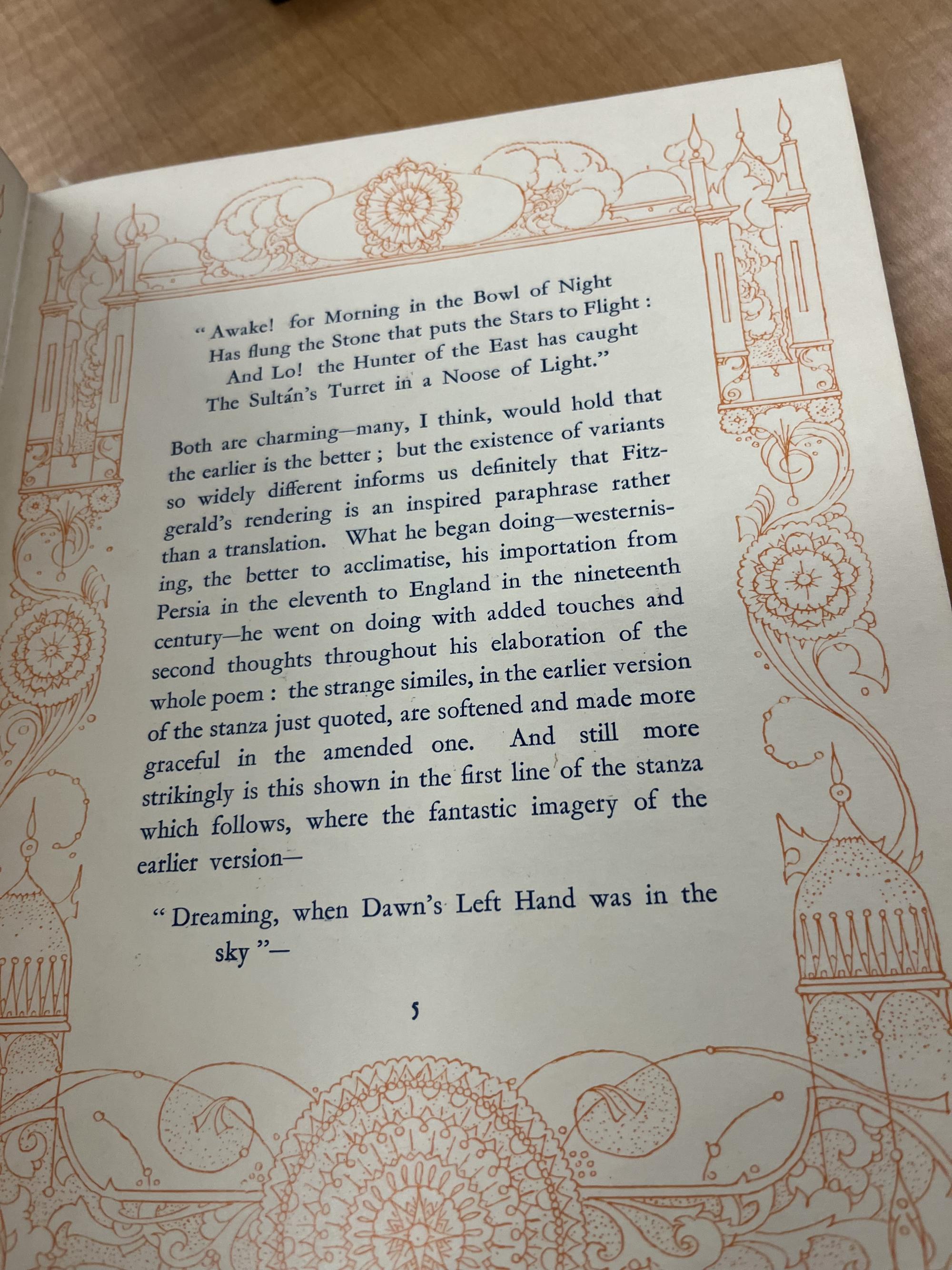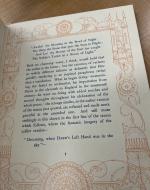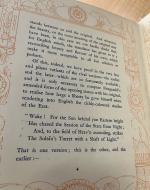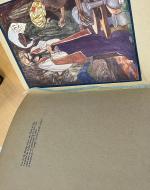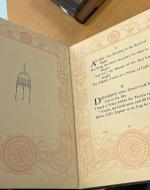Created by Pippa Balderas on Wed, 05/03/2023 - 12:09
Description:
Since the Rubáiyát rose in popularity as a gift book, there are numerous editions of the Rubáiyát that vary in size, style, and extravagance. These gift books typically include extremely high-quality material covers, multiple illustrations, borders around the text itself, and the loveliest font to look at. Yet a lot of the editions include illustrations and decorations that are trying to give off a mystical feeling connected to the East, including Islam. Because of these attributes commonly found in these editions and the poem being turned into a status object of a gift book, scholar Barbara Black claims that these gift books engage with cultural imperialism and Orientalism. Black thinks that because of the contents within the books, the drawings and decorations that appeal to Orientalism, and because they were seen as something to possess and collect, these gift books are Orientalist. She writes, “The poem’s value becomes inseparable from its pretty, crafted, possessive diminutiveness. Khayyam’s verse remains entrenched in the categorically Oriental, in the sand of seers and Eastern serenity; it persists, a bit of wisdom literature that one can hold in one’s hand” (61). The poem gives an appeal to the Western culture because it was originally written in Farsi (Persian) and the author himself was Persian, leading the publishers and illustrators to feed into the appeal for the “Orient”, that it was mystical, an escape for the Westerner. These decorations added in for the appeal of one’s eye become the reason for these gift books, because one could possess an object that encapsulated the mystical feeling of the "Orient", “possessing the text was as important as reading it, if not more so” (61). It is a thing to be put on display, to possess, leading to Orientalism, a power dynamic. In her piece, she quotes another author, Schenker, in regards to how the Rubáiyát is used, “The besieged master or mistress of the house may guiltlessly indulge himself or herself in a momentary escape into [the Rubáiyát’s] amoral world without husbands or wives or fathers or children, or even Englishmen” (63). After FitzGerald translated the poem into English, it has become an object of the East to possess, it is just an object that helps the Westerner escape from his/her typical everyday moral obligations into the “obligations of the East”, having no morality or rules to follow but one’s own pleasure. And the gift books become Orientalist as it promotes these notions with extravagant illustrations and decorations to become a possession, just as the West tries to possess the East as an object.
However, it is hard to prove that every edition has become one of appropriation and contributing to Orientalism. Many editions do not fall into the category that Black brings up, they look unrecognizable when placed next to others. This edition from 1929 complicates Black’s claim that every gift book is one of Orientalism based on the appeal of the illustrations inside the book itself, and how the book is solely for being possessed/owned. Despite the physical size of this 1929 edition, the actual book itself is quite small with only fifty-six pages (that are counted towards page count, the other pages for illustrations are not given page numbers). Fifty of those pages are the actual poem itself, two are just the cover, two are the biographical note at the end, and the remaining twelve belong to the introduction. This introduction by Laurence Housman complicates this gift book because of how focused it is around the poem and the contents itself, not the way that it would make someone feel or how it is from the “East” adding in a certain kind of attraction [see images 1&2]. Housman directly states that “For the translator of poetry and vision always stands between us and the original. And whatever the beauty, or the exact meaning of the original may have been. . .the translator has given to it a reconciling beauty and flavour of his own, which make[sic] it more acceptable to all but scholars and pedants” (3-4). Housman mentions how this is a translation of another piece a couple of different times and how it creates two different poems given that it is a translation. He even notes that besides scholars and pedants, the average person or even writer will find beauty in the translated version even if it is far removed from the original. We can appreciate this translated version of the poem and recognize that it is different than the original. He focuses all his attention on the introduction about the contents and different versions of FitzGerald’s translation.
The illustrations and decorations both complicate and fuel Black’s claim. The four illustrations that the book contains complicate Black’s claim because they are not the center of attention. When the illustrations show up, they point to the poem because they represent a certain line in the stanza that is attached to it. These illustrations give into Orientalist art given that Charles Robinson made the men in the illustrations dressed in attire that would be seen in Persia [see images 3&4]. However, when comparing these illustrations to other pieces of Robinson’s work, such as his art featured in children’s books, they are very similar in style and give a mystical/otherworldly feeling around each one, just like these illustrations in this edition. They do not play into the flashy Orientalist art that can be found in many gift books of the Rubáiyát, which brings them away from Black’s claim. However, the decorations on the title page and every other page give into Black’s claim because they display more attributes contributing to Persian cultures, such as the usage of arabesques and the towers looking like Sultan’s tower or the minbar or minaret of a mosque. This piece of the edition seems to give Black’s claim fuel because it uses the gift book as a form of attraction towards Orientalism with these decorations, but considering these decorations with the rest of the edition, the illustrations, and introduction, this edition feels more like it is focused solely around the actual poem itself, and the rest of the pieces in the edition are just to try and make the book look pretty for the sake of having a nice book.
References:
Black, Barbara J. On exhibit: Victorians and their museums. University of Virginia Press, 2000.
Khayyám, Omar. Rubáiyát of Omar Khayyám. Translated by Edward FitzGerald. Illustrated by Charles Robinson. Collin’ Clear Type Press, 1929.

